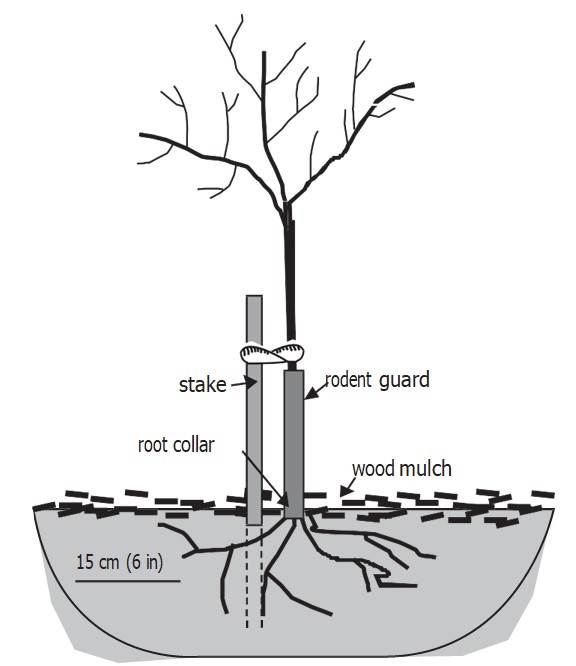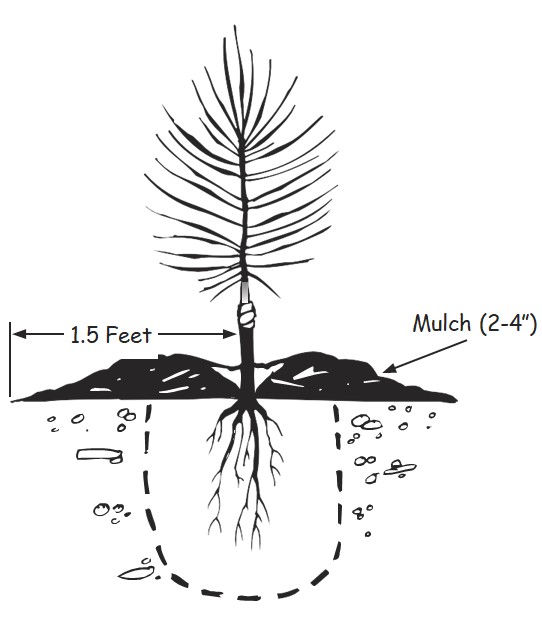How to Plant Trees on Your Property
Balled and Burlap or Potted Coniferous Trees
Planting Site
- Clear any debris (stumps, rocks, etc.) from the planting site.
- Avoid planting in wet depressions.
- If you are unsure of buried utilities, call before you dig – Ontario One call 1-800-400-2255 or on1call.com.
- Where not to plant:
- Under utility wires (plant at least 5 m/16 ft away)
- Within a road allowance
- Over septic systems
- Under the crown of a live tree
- Close to buildings
- Near field tiles or drain outlets
- Follow municipal setbacks from drains
Planting Instructions
- Lift the tree by the pot or under the root ball. Do not lift it by the trunk.
- Before planting, ensure that the soil within the pot or burlap is moist.
- Dig a planting hole 30 cm (12 in) wider in diameter than the root ball.
- Dig the hole just deep enough that the soil in the pot or root ball is level with the ground and the tree sits on a firm base.
- Lower the potted or balled and burlap tree into the hole, checking for depth and fit.
- Potted trees: remove the tree from the hole, slide off the pot (disturbing the root system as little as possible) and put the tree back in the hole.
- Balled and burlap trees: Place the tree in the hole with burlap intact then carefully cut the twine away from trunk, untie the burlap, and fold back (burlap will decompose).
- Ensure the tree is vertical.
- Firm tree in with a mixture of topsoil and compost to eliminate air pockets.

Potted or balled and burlap coniferous tree
Mulching and Weed Control
- Mulch with composted hardwood chips to a depth of 5-10 cm (2-4 in) to reduce weed competition, retain moisture, and reduce fluctuations in soil temperature.
- Spread the mulch in a circle around the tree, keeping it away from the trunk to avoid stem rot.
- Do not use string grass / weed trimmers around any trees, regardless of size.
Watering
- Ensure trees are thoroughly watered at planting.
- In times of drought, water thoroughly once a week.
Bare Root Deciduous Trees
Transporting
- When transporting trees, keep bare roots moist by wrapping them in wet burlap and a tarp.
- Trees should be planted immediately or heeled in to keep roots from drying out.
Planting Site
- Clear any debris (stumps, rocks, etc.) from the planting site.
- Avoid planting in wet depressions.
- If you are unsure of buried utilities, call before you dig – Ontario One call 1-800-400-2255 or on1call.com.
- Where not to plant:
- Under utility wires (plant at least 5 m/16 ft away)
- Within a road allowance
- Over septic systems
- Under the crown of a live tree
- Close to buildings
- Near field tiles or drain outlets
- Follow municipal setbacks from drains
Planting
- Keep the tree roots moist and protected until the hole is prepared.
- Dig a planting hole 30 cm (12 in) wider than the diameter of the root system.
- Place the tree in the hole and make sure the roots fit without bending or breaking (do not prune roots).
- Check for depth. The root collar should be even with ground (the root collar is where there is a slight change in colour and/or swelling where the stem meets the root ball).
- Hammer in the stake before backfilling with soil to avoid damaging the roots.
- Ensure the tree is vertical.
- Alternately backfill hole with compost/topsoil and tamp down to eliminate air pockets.
Staking
- In windy locations, place wooden stake 15-20 cm (6-8 in) from stem on the prevailing wind side of the tree (do this before backfilling).
- Secure the tree to a stake at 1/3 the height of the tree using a plastic tree tie or burlap in a figure eight pattern.
- Leave the tie slightly loose to allow natural movement which encourages growth.
- Remove stake in one to two years.

Bare root deciduous tree
Rodent Protection
- Place a rodent guard around the stem to protect it from mice and rabbits during winter months.
Mulching and Weed Control
- Mulch with composted hardwood chips to a depth of 5-10 cm (2-4 in) to reduce weed competition, retain moisture, and reduce fluctuations in soil temperature.
- Spread the mulch in a circle around the tree, keeping it away from the trunk to avoid stem rot.
- Do not use string grass / weed trimmers around any trees, regardless of size.
Crown Pruning
- Carefully prune any dead, broken, or damaged branches.
Watering
- Ensure trees are thoroughly watered at planting.
- In times of drought, water thoroughly once a week.
Bare Root Seedlings
Transportation
- Handle trees gently – do not throw, drop, stack, or sit on the bags.
- Keep the trees cool during transportation and do not leave them in a vehicle for extended periods of time.
Storage
- Ideal storage temperature for trees is 2-5ºC. Store them in a cool area of the barn, garage or basement.
- Plant the trees within 24 hours.
Getting Ready
- Do not open bags until ready to plant.
- Never leave the roots exposed.
- Keep the roots moist by securely resealing partially used bags and returning them to a cool location.
- Cut the elastics around the bundles instead of ripping them off.
- Carefully separate the roots without damaging them. Do not prune the roots.
- If the roots seem dry, dip them in water but do not leave them submerged in water.
- Keep the roots moist by placing them in a bucket or planting bag with a little water in the bottom.
Planting Site
- Proper site preparation is essential to control weed competition. Talk to UTRCA forestry staff for advice.
- Clear any debris (stumps, rocks, etc.) from the planting site.
- Avoid planting in wet depressions.
- Where not to plant:
- Under utility wires (plant at least 5 m/16 ft away)
- Within a road allowance
- Over septic systems
- Under the crown of a live tree
- Close to buildings
- Near field tiles or drain outlets
- Follow municipal setbacks from drains
Planting
- Remove sod prior to digging.
- The planting hole must be deep and wide enough to accommodate the entire root system, allowing the roots to hang straight down in the hole in a natural arrangement. Do not bunch, wrap, spiral, or bend the roots.
- Check that the seedling is vertical and cover the roots with soil. The soil should be level with the root collar (where there is a slight change in colour and/or a swelling on the trunk).
- To remove air pockets and prevent the roots from drying out, tamp on the soil firmly with your toe.
- Do not bury and branches or leave any roots exposed to the air.

Bare root seedling
Mulching and Weed Control
- To reduce weed competition, either mulch with composted hardwood chips or apply herbicide.
- Mulch will also retain moisture and reduce fluctuations in soil temperature. Spread mulch in a circle around the tree to a depth of 5-10 cm (2-4 in), keeping it away from the trunk to avoid stem rot.
- Cut the grass between the rows two or three times during the growing season.
- Do not use string grass / weed trimmers around any trees, regardless of size.
Watering
- Water the trees if there is an extended dry spell.
Markers
- Place stakes outside the last row of trees to protect them from being cut or plowed under.
For information on the UTRCA’s tree planting programs, please contact a forestry staff member:
Rob Davies, Forestry and Restoration Supervisor
[email protected]
519-451-2800 ext. 243
Brenda Gallagher, Forestry Technical (Vegetation)
[email protected]
519-451-2800 ext. 260
Greg Urquhart, Forestry and Restoration Technician
[email protected]
519-451-2800 ext. 281

